You'll know this flowering houseplant as either Hippeastrum or Amaryllis. Debate about the true name of this plant, grown from a large sized bulb, has raged for centuries (literally) and the eventual winner was Hippeastrum. The history is complex, so just below this stunning photo is a bite sized snack to help explain it all.
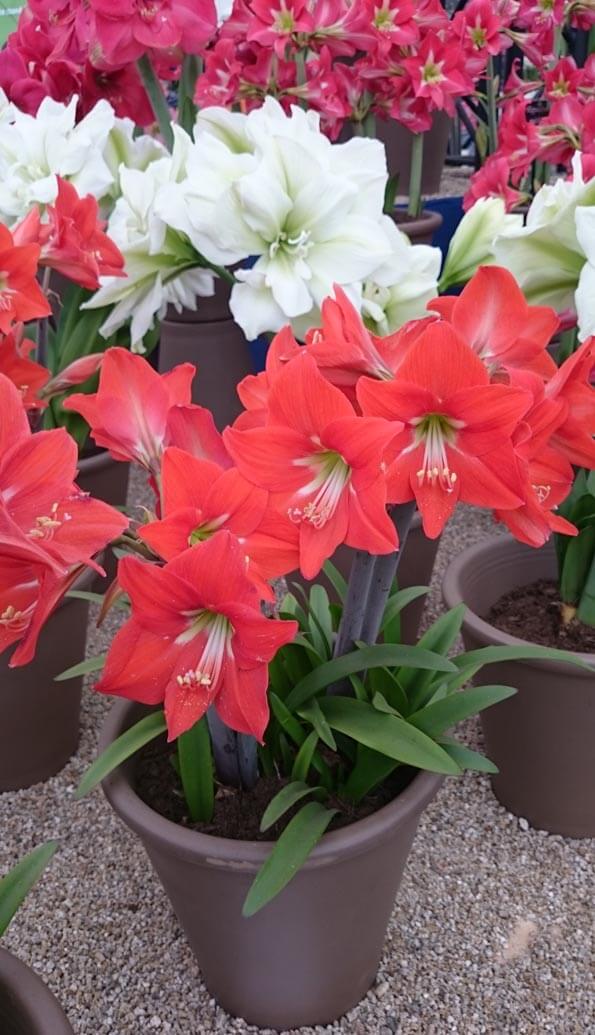
Basically the true Amaryllis is an outdoor flowering plant, the most popular being the Belladonna Lily or Naked Lady. Leaves appear for several months until they eventually die back to nothing.
A few months later the stored energy is released through the rapid growth of leafless stalks rising out of the ground, on which fantastic pink lily like flowers appear. The plant is very unusual and interesting because the flowers appear without any leaf support. However the interest stops with gardeners because the true Amaryllis only grows outdoors.
Our indoor flowering bulb (the subject of this article) should in theory correctly be called and known as Hippeastrum. These are bulbs which are related to Amaryllis but have been cultivated so they can grow indoors and will bloom in Winter months.
The colours of the flowers are more varied and diverse in shape than the outdoor Amaryllis and as a result they are far more common, popular and sought after.
It took until 1987 to basically decide how the plants should be named, but it's still very common to still find people calling Hippeastrum, "Amaryllis" and the other way around. Essentially it doesn't really matter what you decide to call it because the majority of people will know what plant you're talking about.
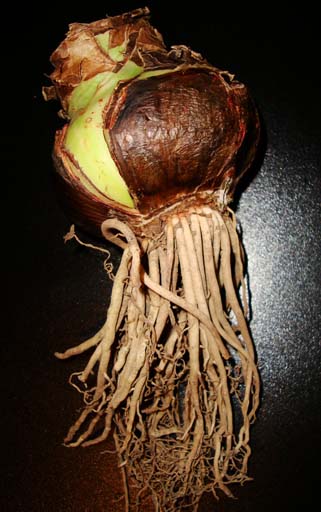 The large bulbs are often brought as festive gifts in their dormant state which can then be "awoken" to flower in late Winter or early Spring.
The large bulbs are often brought as festive gifts in their dormant state which can then be "awoken" to flower in late Winter or early Spring.
Although incredibly showy, beautiful and impressive they are normally very expensive to buy, when compared to other indoor flowering bulbs you can get at the same time for a fraction of the cost, such as Hyacinths and indoor daffodils.
However there is no doubt these houseplants are show stoppers and because they're "reusable" they can repay the initial investment over several years.
To ensure your plant gets a chance to make this happen, after flowering has finished the bulbs should be kept and allowed to build their energy reserves for the following year. In this way they can be permanent Winter / Spring house guests.
A more extensive how to guide for keeping your Hippeastrum flowering year after year can be found further down in this article.
There are two general rules when it comes to successfully growing an amazing looking Hippeastrum. Firstly do not confuse it with the true Amaryllis which needs to be grown outdoors, while neither is actually frost hardy, the Hippeastrum will rot easily if over watered or when exposed to even a mild frost. Therefore don't plant it outside when flowering has finished or keep it outside when the temperatures start to dip.
Secondly, the size of the bulb is directly proportional to the size and number of flowering stalks. A large heavy bulb may produce three flowering stalks where as a smaller one perhaps only one. Basically if you have the choice, always buy the biggest bulb you can find.

Hi, I'm Tom!
If you're like me and enjoy the challenge of growing houseplants and getting them to thrive, then Ourhouseplants can help. This website shares my knowledge and years of growing plants and provides (hopefully) helpful advice on properly caring for your indoor plant friends.
Bright light with some sun for part of the day is a must for your Hippeastrum if you are hoping for a repeat flower display next year. Too little light during the flowering period will also result in the stalks bending towards light sources and increasing the chances of it falling over.
Don't let the bulb "sit" in water as this will cause it to rot.
If brought in the dormant state you want to water just enough to ensure the soil is evenly moist then wait until growth starts before watering again. When "actively growing" (so when the leaves have fully emerged) and the temperature is warm aim to keep the soil moist for most of the time, reducing water as you head towards Autumn / Fall before stopping completely.
It's so easy to cause a Hippeastrum and Amaryllis bulb to rot from overwatering so don't ever let the bulb "sit" in water at anytime.
Neither Hippeastrum or Amaryllis are very fussy about humidity. But remember that very humid locations will need less watering overall than locations which are very arid because the potting soil will take longer to dry out.
Only feed when the flowers have faded and the leaf straps have emerged from the plant itself. Try and feed every couple of weeks or so during the Summer and stop just before Autumn / Fall begins. This will help the bulb to "fatten" up, ready for it to create some (hopefully) speculator blooms early the following year.
When you first get your Hippeastrum, if it's not already in bloom or showing flowering shoots then you need a warm location to get things moving. Warmth along with a little moisture will awaken a dormant bulb and then if you keep it warm you'll have flowering shoots heading for the ceiling in no time.
If you keep the same warmth when the flower buds are due to open and immediately after this, then the flowering period will be very short. So if you want to slow the overall growth (you may be hoping to get it to bloom for a certain date for example) or want to prolong the life of the blooms once they've opened up fully, then cool things down.
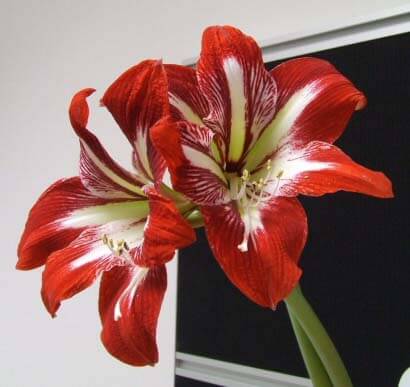 Just like a bunch of cut flowers you buy from a shop they'll last longer if placed out of direct sunlight and in a cooler room. With that said neither Hippeastrum or Amaryllis will take "cold" conditions and frost must be avoided at all costs.
Just like a bunch of cut flowers you buy from a shop they'll last longer if placed out of direct sunlight and in a cooler room. With that said neither Hippeastrum or Amaryllis will take "cold" conditions and frost must be avoided at all costs.
Repotting your Hippeastrum is only needed if the original pot is very small to start with, the existing potting medium has broken down or the plant has produced so many offsets that it needs more space. There is no need to repot each year or to even remove the bulb from the existing pot during the rest period.
If you ever do repot, assuming you choose to put it in a different pot, ensure the new container is only a little bigger than the previous one and use a good quality compost. Remember the bulb only needs to be half covered as full coverage will increase the chances of it rotting.
Hippeastrum will produce offsets quite often which is the good news. The bad news is that they take a very long time to reach a really good size, which is required before they will produce flowers of their own. Often it's best to leave the offsets next to the parent plant for several years.
Eventually they will be big enough to be separated from the parent bulb and grown on by themselves. To do this remove the entire plant from the container and gently remove the offset(s). By this point it will have some of its own roots too, so carefully detangle them and make sure the offset takes some with it when separated,
You should easily have flowers well within two months of the plant waking from the dormancy period. Warm temperatures will quicken the speed of growth massively.
The flowers will often fade between a couple of weeks up to a month after first opening, and over the following months after that, green strap like leaves will fully grow and extend from the bulb. These will eventually die back as Autumn / Fall arrives, things get cooler and if you reduce watering.
Hippeastrum and Amaryllis grow to different sizes and heights so it's difficult to give exact specifications. Sometimes the flowering stalk is very tall approaching 75cm / 30in with huge dinner plate blooms that need support to keep them upright.
Other times they're quite compact and dainty and won't need any assistance to keep them upright. Always check the tags or labels that come with the plants for more precise guidance.
Hippeastrum is one houseplant that doesn't disappoint when it comes to attention grabbing flowers. 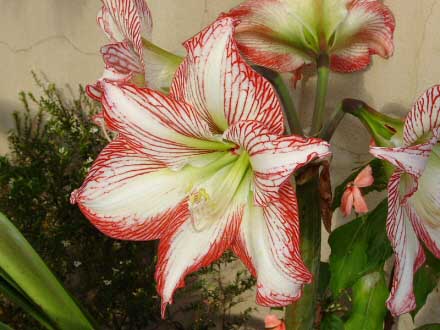 Bold, huge and varied. They will capture passerby's and will win over the hearts of mortal enemies (maybe). It's common to get four or five of these showy flowers per main flower stalk or stem. Of which there are often one or two, if the bulb is quite small or still young then there will likely only be one flower stem.
Bold, huge and varied. They will capture passerby's and will win over the hearts of mortal enemies (maybe). It's common to get four or five of these showy flowers per main flower stalk or stem. Of which there are often one or two, if the bulb is quite small or still young then there will likely only be one flower stem.
Each flower is often between 13-20cm / 5-8in across coming in many different colours and patterns. They're usually funnel shaped and this can be seen clearly with the single varieties, they also come in a double form. The "traditional" Hippeastrum typically has six petals although there are more introductions all the time with different "looks" and shapes that differ greatly from the "traditional" style.
There are toxic compounds within this plant, and although they are sparse in the stem, leaves and flowers they are quite concentrated in the bulb. You should be careful if you've inquisitive pets.
There is a yearly cycle which you will enter at some point when you acquire Hippeastrum and it goes like this.
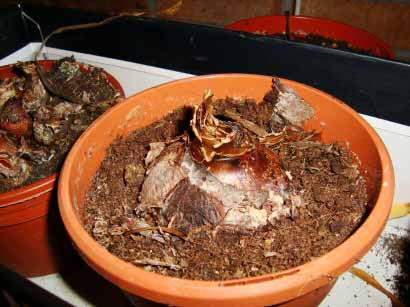 Dormant Bulb - A dormant bulb will be as the name sounds, "dormant". They'll be no growth of any kind although parts may appear green or there may be very tiny shoot tips at the next of the bulb. At this stage all you need to do is "wake" the bulb. Once you do so, it should be in flower within two months, so if the flowering time is something you want to plan for consider when you do the next bit carefully.
Dormant Bulb - A dormant bulb will be as the name sounds, "dormant". They'll be no growth of any kind although parts may appear green or there may be very tiny shoot tips at the next of the bulb. At this stage all you need to do is "wake" the bulb. Once you do so, it should be in flower within two months, so if the flowering time is something you want to plan for consider when you do the next bit carefully.
Waking the Bulb - The bulb should be planted in good quality compost with only the bottom half of the bulb actually covered. Water it well once and then bring indoors to a warm semi bright spot. This will awaken the plant and a few leaves and the flower stalk(s) will start to grow from the top over the next month or so. Don't keep watering the plant at this stage, the original watering is all that is needed until the flower stalk(s) is clearly visible a few inches above the bulb at which point aim to keep the soil just moist.
Flowering - Several weeks later the flower stem will grow rapidly before eventually opening. 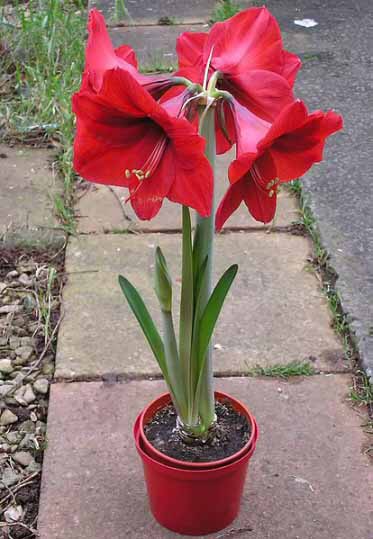 Often one stem will flower fully and when that fades the following ones will start their display. Therefore although each bloom is quite short lived the display will last for several weeks, possibly a month or longer.
Often one stem will flower fully and when that fades the following ones will start their display. Therefore although each bloom is quite short lived the display will last for several weeks, possibly a month or longer.
Leaf Growth - After the flowering period is over you can remove the dead flowers. The leaves which will have already started to show themselves will fully emerge and grow. As far as houseplants go they aren't especially showy or attractive, so if you don't want the plant around your home at this stage you can move it outdoors (providing all danger of frost has passed). Water well and feed at regular intervals for the next few months.
Triggering Dormancy - Just like the Amaryllis growing outdoors, a period of dormancy is needed to trigger flowering. At the end of Summer / start of Autumn / Fall reduce watering. If the plant is outside this will cause the leaves to start yellowing and dying back. Eventually all that will be left is the odd stray leaf or just the bulb itself which is what you want.
At this stage move to a cool but frost free place for around two months. The soil needs to be dry so don't water at all during this time or provide warmth both of which can prevent or break the dormancy period. After this "rest" the cycle is complete and can be started again as detailed above.
Rotting Amaryllis / Hippeastrum Bulb
Exposure to frost or overwatered, usually the culprit is the latter. When coming to water, if in any doubt that the soil might be moist enough already it's best not to risk it. A heavily rotten bulb is normally the end of the line for your plant, although any offsets might be salvageable.
The flower stalk has gone yellow
After flowering the flower stalks will start to go yellow and die. Don't be in a hurry to cut them off as the energy is going back into the bulb, although when all of the green has gone you should remove them.
No flowers on my Amaryllis
The bulb is either too young, too small or the growth cycle has not been followed correctly.
Floppy or lanky leaves
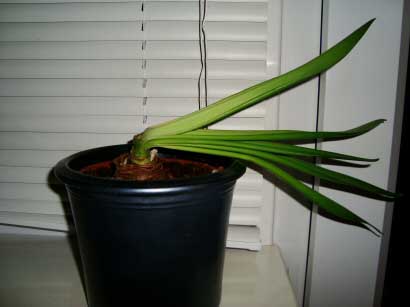 Unfortunately this is quite common when temperatures swing between hot and cold and vice versa. Classically this occurs in Winter; during the days we have the central heating on in our living areas and at night we retreat to our bedrooms where the living areas rapidly cool. The leaves / flowering stalk will recover but consider providing some structure support.
Unfortunately this is quite common when temperatures swing between hot and cold and vice versa. Classically this occurs in Winter; during the days we have the central heating on in our living areas and at night we retreat to our bedrooms where the living areas rapidly cool. The leaves / flowering stalk will recover but consider providing some structure support.
My Amaryllis / Hippeastrum keeps falling over
Many Hippeastrum's have been bred to produce amazing blooms that they wouldn't naturally, some of which are very large and heavy. Many of these varieties will need some support to stop them falling over so consider inserting a wooden or plastic stick to support the flowering stem. If it does topple, you risk it snapping and ruining your hard work so if there is any concern get that support in place.
Credit for the red Hippeastrum photo - Article / Gallery - Daniel Macher
Credit for the red and white Hippeastrum photo - Article / Gallery - Antonio solera